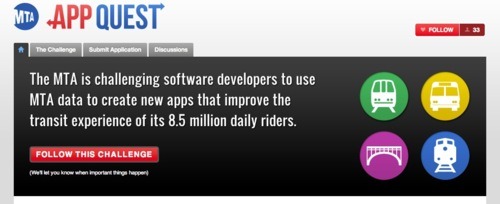
Nearly five months after first announcing the MTA AppQuest challenge and after a few unavoidable delays, a group of new transit apps are ready to face the public. The authority announced last week that, after two delays in the submission date, they received 42 submissions for their app contest, and public judging is now open at MTAAppQuest.com.
“We’re thrilled at the partnership that has developed with the tech community to bring new innovations to our riders at no cost to the MTA,” the authority’s Executive Director Joseph said in a statement. “We’ve got a great crop of apps and we can’t wait to see which ones the public likes best.”
Public voting will be open through January 11, and the MTA and ChallengePost will award two winners. The winner of the public voting will take home $2000 while the runner-up will earn $1000. The MTA is not contributed financially to the prize money.
In addition to the public voting, a group of judges –including me — will also evaluate the apps. Joining me on the panel will be the following:
- Jen Chung, Executive Editor, Gothamist, and Co-Founder, Gothamist LLC
- Jeff Ferzoco, Creative and Technology Director, Regional Plan Association
- Cas Holloway, Deputy Mayor for Operations, City of New York
- Mark Gorton, Founder and Chairman, OpenPlans and Founder, Tower Research Capital LLC
- Wael Hibri, Chief Enterprise Information Officer, Metropolitan Transportation Authority
- Noel Hidalgo, Director of Engagement Technologies, World Economic Forum
- Lawrence Levy, Executive Dean, National Center for Suburban Studies at Hofstra University
- Rachel Sterne, Chief Digital Officer, City of New York
The winners of that contest will take home $5000 with second and third place worth $3000 and $1500 respectively. I haven’t yet had the time to explore all of the offerings yet, but right now, City Maps and NYC Station Finder are in the lead. The MTA, meanwhile, is profiling each app on its Facebook page.
With 42 submissions, the contest has seemingly been a success for the authority as it looks to outsource its app process to developers with the skill and wherewithal to create these on-the-go resources. The challenge, though, was not without hiccups. Originally slated to end in September, the MTA had to push back the submission date twice to both prepare more data for developers and all coders more time to complete their submissions. Furthermore, as Transportation Nation notes, the biggest possible data dump — an API that ties into the system’s new countdown clocks — isn’t yet available. Such a move could truly revolutionize commuting patterns.
I’ll try to have more on these apps over the next few weeks. In the meantime, head on over to the AppQuest homepage and vote for your favorites.













